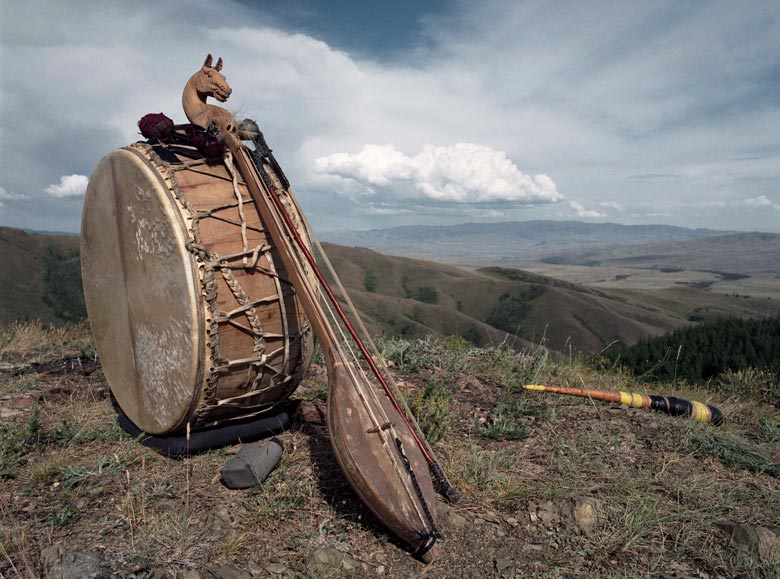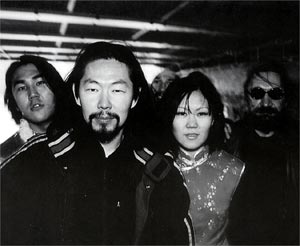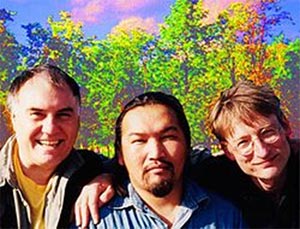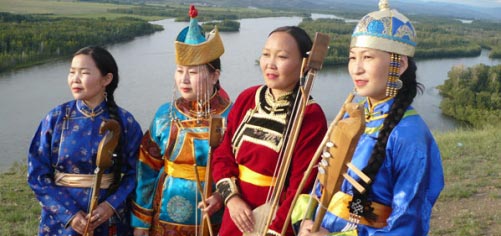Transcending Place


Yat-Kha

K-Space
Saddle and rein are rinkling-rinkling
On my sweetheart’s braid
Her braid ornament is swaying-swaying
Trotting up the river Khemchik
Such is the pace of the arched dun horse
Always coming when evening falls
Such is the habit of my young love.
Yat-Kha – “Eki Attar” from Tuva.Rock, 2003
While the shift away from Tuva’s traditional lifestyle does present many challenges, musical experimentation provides a more hopeful image of how tradition and contemporary circumstances can fruitfully coexist. Even in what could be considered a strain of Tuvan, or even Russian, alternative rock, traditional lyrics are not sacrificed and the dramatic mindsets often remain unchanged. Poetic relationships between human and land are maintained with just as much traditional integrity when laced with cross-cultural influence, only spoken through different instruments.
Perhaps the most pivotal group in Tuvan musical experimentation has been Yat-Kha. The oft-changing ensemble is charged with the distinctive energy of vocalist Albert Kuvezin, who originates from the more traditional group Huun-Huur-Tu. The collaborations of Huun-Huur-Tu have included the heart-breaking warble of Bulgaria’s Angelite choir and the drumming of the Kodo taiko group of Japan’s Sado Island, while Yat-Kha creates a magnetic field between Tuvan folk and Western rock. Both bands generally perform traditional motifs and sometimes lyrically express nostalgia for Tuva’s traditional lifestyle, but they also selectively pluck international influences that enrich the sounds of Tuva, not drown them.
“Eki Attar” is cheerful and romantic folk song textured with plenty of alliteration in the Tuvan language, but when performed by Yat-Kha on their 2003 album Tuva.Rock, it transforms into a rumble of head-thrashing metal punctuated with grim kargyraa. “Teve Khaia”, off of the same album, celebrates the landscape of Tuva through a palette of melodic rock, traditional instruments, powerful female lead vocals, and again, the coarse kargyraa of Kuvezin. More recently, when Kuvezin found inspiration on the Scottish island of Jura for his 2010 album Poets and Lighthouses, he alchemically fused throat singing with English translations of Japanese post-war poetry, sealing the eclectic combination with determinedly Tuvan appeals to forest and mountain spirits.
Ensembles like Yat-Kha inspire free experimentation where folk is not subject to cryogenic freezing. Traditional music that does not evolve may not find much relevance in the post-Soviet and contemporary tastes of people who were exposed to Pink Floyd, Deep Purple, and Black Sabbath, along with the new generation of world singers and bands today. At the same time, in order to avoid cultural colonization, those regional traditions need to be internally preserved in some form.
For example, different artists will often use the same folk song in varying arrangements, or the same artists will dramatically reinterpret these songs on separate albums. This, in effect, removes a certain sense of entitlement and ownership, preserving the community significance of Tuvan folk as opposed to individualizing it. It is also a direct challenge for artists to embrace musical experimentation. Instruments like the igil and khomous — a two-stringed lute-like instrument and a resonant metal mouth harp, also known as the jaw harp — have found a natural camaraderie with guitars, drum sets, and synthesizers, while the region’s own shamanic dungur drum has also easily translated into an uncustomary realm of performance. Even allusions to Western ecclesiastical choral arrangements have been explored, as in the group Shu-De’s 1994 album, Voices from the Distant Steppe.6
Thus far, Tuva’s tenacious musical and lyrical traditions have not had to distort out of regional harmony to accommodate new aesthetics, despite global attention and stylistic experimentation.
[audio:/wp-content/uploads/2013/05/Tuvan_10_Huun-Huur-Tu_Midnight-Tale.mp3|titles=Huun-Huur-Tu – Midnight Tale]
Huun-Huur-Tu & Carmen Rizzo – “Ancestors Call”
[audio:/wp-content/uploads/2013/05/Tuvan_11_Huun-Huur-Tu-Carmen-Rizzo_Ancestors-Call.mp3|titles=Huun-Huur-Tu and Carmen Rizzo – Ancestors Call]Yat-Kha – “Karangailyg Kara Hovaa Dyngyldai”
[audio:/wp-content/uploads/2013/05/Tuvan_12_Yat-Kha_Karangailyg-Kara-Hovaa_Dyngyldai.mp3|titles=Yat-Kha – Karangailyg Kara Hovaa Dyngyldai]Yat-Kha – “Eki Attar”
[audio:/wp-content/uploads/2013/05/Tuvan_13_Yat-Kha_Eki-Attar.mp3|titles=Yat-Kha – Eki Attar]Albert Kuvezin & Yat-Kha – “The Cry”
[audio:/wp-content/uploads/2013/05/Tuvan_14_Albert-Kuvezin-Yat-Kha_The-Cry.mp3|titles=Albert Kuvezin and Yat-Kha – The Cry]The Women Who Sing Khoomei
To identify one of the most ethereal and emotional fragments of any culture’s music is no doubt to encounter the voice of a woman. Once uncommon due to prevailing beliefs that prohibited them from singing,7 women are gradually finding the space for expression within this tradition today, resulting in Tuva’s own “girl group”, Tyva Kyzy.
“There are some things that are prohibited for various people in traditional societies and traditional ways of life. This prohibition is tied in with ethics, aesthetics, religions, and humanism. Women and children were prohibited from doing many things. Searching to understand why women cannot sing khoomei, I found facts that women did sing khoomei…” explains Choduraa Tumat of Tyva Kyzy. “… starting with examples from the heroic epic of Boktu-Kirish and Bora-Sheelej, to the woman Choldak-Kara Oiun during the feudal era. With time, the meaning and purpose of these prohibitions — not only those regarding khoomei, but also others — changed and transformed; their explanations also changed. And these very bans are interpreted today from a more sociological side, as opposed to a physiological one.”
Female throat singing naturally brings new vocal elements to a traditionally male performance, allowing for a palette that is already rich with color to become even more saturated with Tuva’s life and energy. Gradients of romance and ritual, joy and sadness, folk tales and ballads can all find a rebirth in the growing acceptance and dynamic adaptation of an old form to a new time.

TYVA KYZY
CHODURAA TUMAT
Footnotes ___ Back to Top
6 “Voices from the Distant Steppe”, Real World Records. Retrieved 2013-04-16.







Very educating!
Thank you for information!
I will wait for more to come from this author.
[…] Tuva’s Meridian of Musicality, Spirituality, and Cross-Cultural Place: A Primer On Tuvan Throat Singing: http://www.redefinemag.com/2013/tuvan-throat-singing-musicality-spirituality-cross-cultural-place/ […]
[…] http://www.redefinemag.com/2013/tuvan-throat-singing-musicality-spirituality-cross-cultural-place/3/ […]
[…] TUVA’S MERIDIAN OF MUSICALITY, SPIRITUALITY AND CROSS-CULTURAL PLACE: A PRIMER ON TUVAN THROAT SINGING // http://www.redefinemag.com/2013/tuvan-throat-singing-musicality-spirituality-cross-cultural-place/ […]